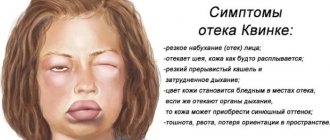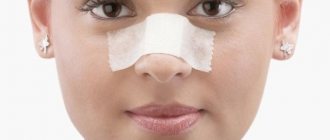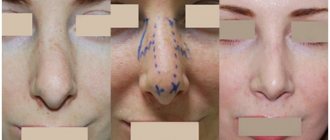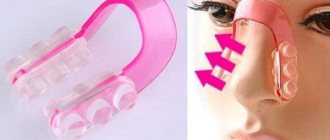First aid for a fracture
If the injury is recent, conservative treatment is sufficient. The specialist carries it out:
- By placing the bones in the correct position with your fingers or using a spreader. If they are displaced sideways or upwards, then a specialist’s hands are enough to realign them. In case of retraction, it is better to use an expander. This is a tool that is used to put displaced sections of bone back into place.
The process, whether done with fingers or with a dilator, is painful, so it is performed under local anesthesia (lidocaine injection). To prevent broken bones from moving again, cotton swabs are placed in the nasal passages. Still, this is an unreliable method of treatment, since after the turunda is removed, the problem may arise again.
- Repositioning of bones using special devices. The essence of the method is the same as with the first method. But here they use general anesthesia, and nasal elevators are used to move fragments. And after fixing the bones in the correct position, they are held by inserting a special tampon into the nostrils. It has a rubber outer coating, which prevents it from sticking to the mucous membrane. The tampon has holes through which fluid flows out.
Treatment methods
It will take more than one week to restore the nasal mucosa after using vasoconstrictor drugs. It is necessary to stop taking them and to alleviate the condition and switch to rinsing with saline solutions (Delufen, Aqua Maris, Salin, Humer). Functions will gradually normalize and symptoms will subside.
To restore the nasal mucosa as a result of 1-2 degree burns, no special local measures are required. Immediately after an injury, rinsing with a light stream of cool water is indicated. If prescribed by a doctor, you can undergo a course of antibiotic therapy to prevent the addition of a bacterial infection. To reduce pain, you can use cotton swabs soaked in an analgesic (Novocaine, Lidocaine) only after consulting a doctor, as they can cause allergies. For chemical burns, treatment is carried out in a hospital. Consists mainly of antibiotic therapy and observation.
To treat damaged nasal mucosa, various forms of drugs are used:
- drops and rinsing solutions;
- ointments;
- sprays.
Among drip medications, preference is given to natural-based medications (Pinosol, Pinovit, Malavit-Rino, Vitaon), which have a complex effect and a minimum of complications. These types of nasal drops, in addition to normalizing the functions of the mucosal vessels, correct the characteristics of the secreted secretion (they dilute it, normalize the quantity), and also have an antiseptic and moderate antimicrobial effect.
It is especially convenient to restore the mucous membrane of a child with just such natural drops. For infants and children up to one year old, Nazivin (0.01%), Noxprey-Baby, Aqua Maris, Humer Spray (from 1 month) are recommended. For older children, we can recommend Delufen, Pinosol (from 2 years), Malavit-Rino (from 3 years).
An ointment based on natural oils effectively promotes the restoration of the mucous membrane. Peach and sea buckthorn, as well as rosehip, are used. Peach – helps heal after burns, has an anti-inflammatory effect, helps improve metabolism in the area of application; sea buckthorn – strengthens the vessels of the mucous membrane, normalizes their permeability. Rosehip, like peach oil, stimulates healing after burns and improves metabolism.
A spray, as a form of drug administration to restore damage to the internal surfaces of the nose, has a number of advantages over drops:
- more evenly distributed throughout the mucosa;
- does not leak and can be used anywhere (on the road, in transport);
- has a high dispersion, so it penetrates into tissues faster;
- the dosage of the active substance is adjusted (especially when using corticosteroids).
Most drugs in drop forms are produced in the form of sprays - Humer, Aqua Maris, Nazivin, Noxprey, Nasonex, Avamis, Flixonase.
Burnt mucous membranes can also be treated with modern hardware methods. In particular, using a laser. The method is based on the evaporation of excess capillaries of the mucous membrane and the creation of local controlled ischemia in areas of hypertrophied tissue. At the same time, the trophism of the latter naturally decreases, swelling in the nasal cavity decreases, breathing improves, and the sense of smell is restored. The method is painless, does not take much time and has minimal side effects. The advantage of laser therapy is the elimination of the pathogenetic link of rhinitis, and not the relief of symptoms.
If you do not contact immediately after injury
Failure to visit a doctor on time will result in the bone healing incorrectly in a fairly short time. And her situation will have to be corrected only in six months. This is done through surgery. First, the bone is broken, then placed in the correct position, ensuring normal fusion. This process is more complex than reducing a fresh fracture.
And all the time before the operation, the patient will have to see in the mirror a nose that has shifted to the side or a dent or hump that has formed on it. But the main consequence of an untreated fracture is breathing problems. They can appear even if there are no external signs of the trauma.
Common problems after nasal injuries
Deviated nasal septum
A frequent complication after a nasal fracture, which gradually leads to unpleasant consequences that interfere with normal life and illness. Breathing becomes difficult, the mucous membranes of the nose are destroyed, the respiratory organs become inflamed, etc.
Breathing disorders
Due to curvatures inside the nose, the dynamics, direction and temperature of incoming air do not correspond to the norm. This in itself makes breathing difficult, plus the membranes of the nose become inflamed and breathing becomes even worse.
Ugly nose shape
The appearance of the nose may change immediately after injury due to displacement of bones and cartilage, or gradually due to the slow destruction of the internal structures of the nose, which occurs due to impaired respiratory physiology.
Indications for correction after a nasal fracture
Sometimes damage to the nasal bones causes only pain, swelling, bleeding, and difficulty breathing, but does not make itself known by external changes. It is necessary to correct it if there are the following signs :
- curvature of the nose or the appearance of sunken areas on it;
- unnatural mobility of organ tissues;
- tracing the edges between bone fragments;
- characteristic sound when pressed;
- lacrimation in some cases;
- discharge of light yellow fluid from the nasal passages.
To learn how septoplasty is performed to correct a deviated nasal septum, watch this video:
Surgical treatment is required if additional factors are present:
- More than 2 - 3 weeks have passed since the injury, the nose is deformed;
- the septum is deviated, there is a large hematoma in this area;
- the walls of the nasal sinuses are injured;
- there is damage to the soft tissues of the face.
Surgery to correct the nose can be successfully performed years after the fracture.
Possible complications
The patient is not immune from individual side effects. It could be:
- Allergy to the administered anesthesia.
- Duration of healing .
- Reaction to surgery.
- Susceptibility to infections.
- Bleeding from the nose.
On this topic
- Rhinoplasty
How to reduce your nose with potatoes
- Editorial board of Plasticology.ru
- June 19, 2020
Complications may occur in the postoperative period. The most common are:
- traces of burgundy color in the eye area;
- swelling of the nose;
- nausea;
- feeling numbness , partial or complete;
- the appearance of a runny nose;
- lethargy and weakness;
- increased temperature ;
- minor bleeding.
Only by carefully following your doctor’s recommendations can you reduce the risk of their development to a minimum.
Options for crooked nose surgery
If the defects resulting from a nasal fracture were not corrected in the first 2 weeks, the operation is postponed for 4 to 6 months. Time is necessary for complete tissue regeneration and completion of inflammation. Sometimes this takes a year. With the help of surgery, it is possible not only to return incorrectly fused bones to their place, but also to eliminate the hump and improve the tip of the nose.
Rhinoplasty and its features
Restoring a broken nose to normal appearance and function through surgery is done after a thorough examination. The doctor determines the scale of the intervention, the nuances of correction, the need to use transplants, etc. The operation is done like this:
- the patient receives general anesthesia;
- the doctor makes an incision in the nasal mucosa to gain access to the bones;
- incorrectly fused areas are broken and given the required position;
- if the nasal septum is curved, it is also straightened;
- the wound is sutured;
- Tampons are placed in the nasal passages, and the nose is fixed on top with a plaster cast.
Closed rhinoplasty
Rhinoplasty takes 1.5 - 2 hours, it depends on the scope of the intervention.
After 4 - 7 days, the plaster cast is removed. But the face, especially the nose area, still looks swollen, and there are bruises under the eyes.
During the rehabilitation period, it is important not to disrupt the effect of the operation, that is, the following conditions must be observed:
- avoid getting water on the bandage;
- rinse the nasal mucosa with special solutions;
- protect it from mechanical damage;
- give up sports and physical labor;
- sleep on your back, without turning over on your side or stomach;
- Do not wear glasses for 3 months;
- wash in the shower with warm water, do not go to the bathhouse, do not lie in a hot bath;
- do not sunbathe for 2 - 3 months;
- do not smoke or eat too hot food;
- don't blow your nose.
If you ignore these requirements, you can get complications: infection, tissue necrosis, suture dehiscence. Negative consequences can also manifest themselves in the form of an unsatisfactory aesthetic result. These are noticeable scars, various types of nasal deformities.
Types of nose correction
Depending on the purpose of the operation and the surgical techniques used, the following types of rhinoplasty are distinguished:
- septoplasty - correction of the nasal septum aimed at eliminating deformation, curvature, and developmental abnormalities;
- open rhinoplasty - surgical access is carried out along natural skin folds;
- closed rhinoplasty - surgical access is carried out from the mucous membrane, due to which there are no visible scars left after rhinoplasty;
- non-surgical nose correction - correction of minor cosmetic defects without surgical intervention by injecting special preparations under the skin.
Why is the mucous membrane in the nose damaged?
The nasal mucosa can be injured under the influence of various negative factors. Usually the cause is the incorrect use of nasal drops with a vasoconstrictor effect for too long. These substances dry out the nasal cavity, disrupt the microflora, causing a medicinal form of a runny nose. The disease causes constant swelling in the nose, which can only be relieved by administering a new dose of medication. At the same time, the surface becomes thinner, and it is no longer possible to refuse the drops without special medical care. So, in the end, surgery of varying volumes of intervention may be required to restore nasal breathing.
Other reasons include:
- constant inhalation of dirty air, for example, when working in a chemical production plant, weaving factory, etc.;
- entry of a foreign body into the nasal cavity;
- addiction;
- inhalation of scalding steam;
- curvature of the nasal septum, which provokes a narrowing of the nasal passages and complications of the correct outflow of produced secretions, as a result, the development of ENT pathologies;
- chronic diseases of the kidneys, heart, blood vessels, thyroid gland.
Temporary symptoms of damage to the nasal cavity are observed after surgery. They also occur as a result of taking drugs that burn the inner lining of the nose.
Hypertrophic rhinitis
Hypertrophic rhinitis is a polyetiological disease that can progress over a long time. It is a thickening of the nasal mucosa and hyperplasia of the tissues underneath, replacement of the epithelium with connective tissues. The causes of this pathological growth include:
- frequent recurrences of the runny nose - more than 3 - 5 cases in one year;
- congenital or acquired disorders of the structure of the nasal passages, injuries to the facial skeleton, which ultimately lead to impaired mucus discharge and stagnation;
- exposure to negative environmental factors - long-term stay in places with too low or high temperatures, inhalation of gases, dust, work in hazardous industries;
- heart and vascular diseases - hypertension, atherosclerosis provoke problems with the supply of a sufficient amount of blood with nutritional components to the nasal mucosa, which ultimately leads to tissue hypoxia;
- other pathologies of the nasopharynx are polyps, cysts, adenoids; all diseases cause persistent swelling and tissue hypertrophy in the nasal passages.
Burn of mucous membrane
All burns of the nasal cavity can be divided into 2 large groups according to the reasons that caused them:
- inhalation of hot air, steam, direct contact with fire - this is a thermal burn;
- penetration of chemicals, alkalis, acids into the nasal cavity - chemical burn.
You can get a burn to the nasal mucosa even when treated with peroxide when its concentration is more than 3%. The mucous membrane is highly sensitive to this substance. There are 3 degrees of burn, each with its own symptoms:
- Burning, quite severe redness and swelling.
- The appearance of blisters, which subsequently burst and leave wounds.
- Necrosis of tissue and its subsequent rejection.








